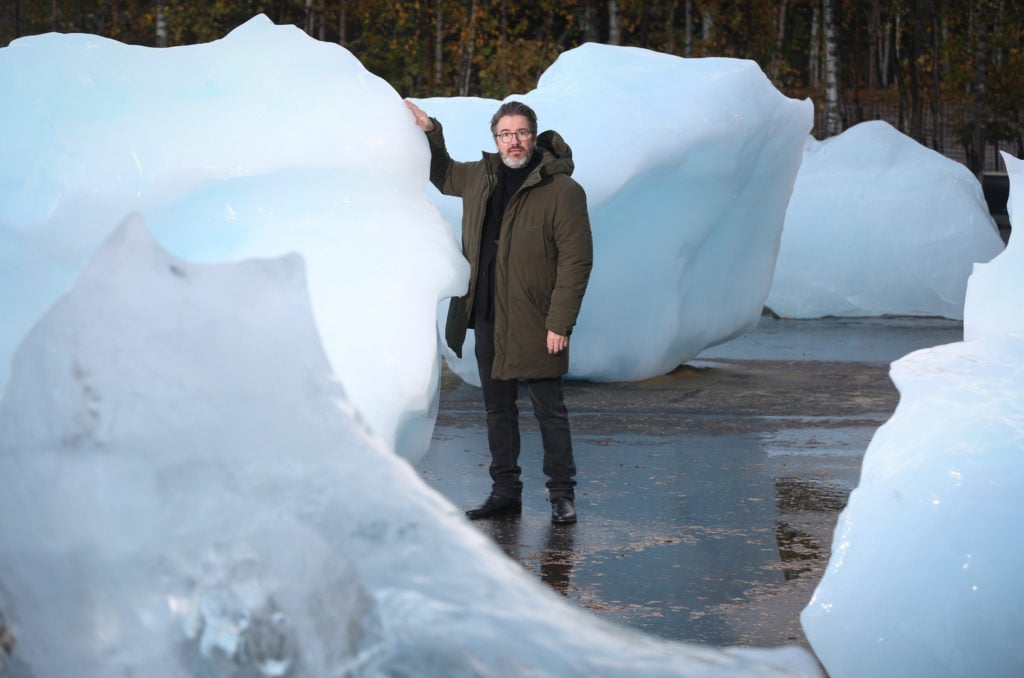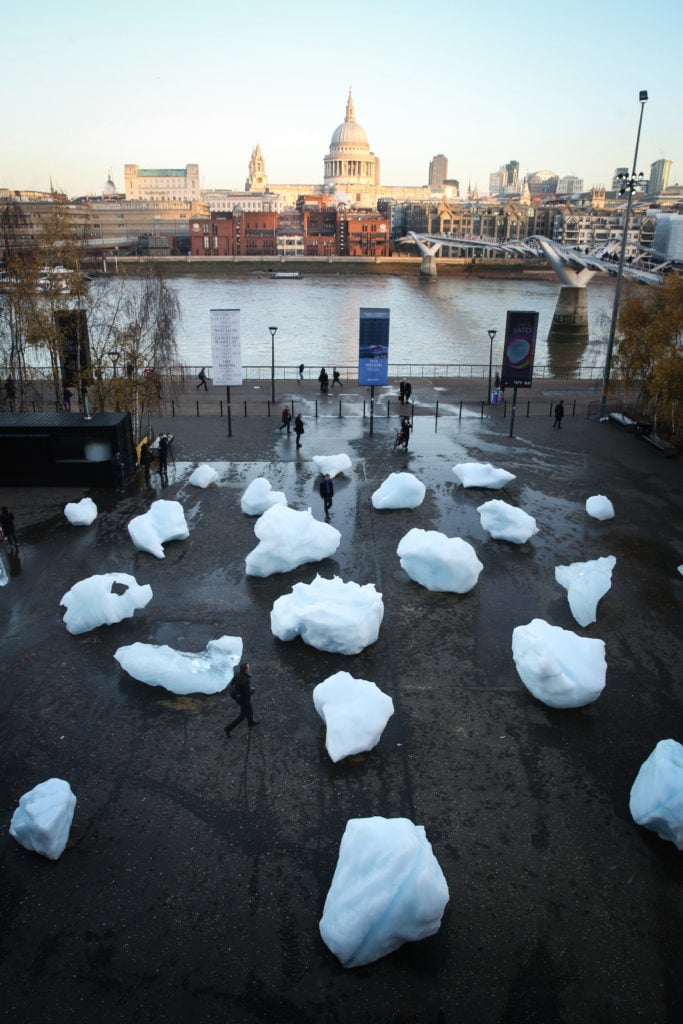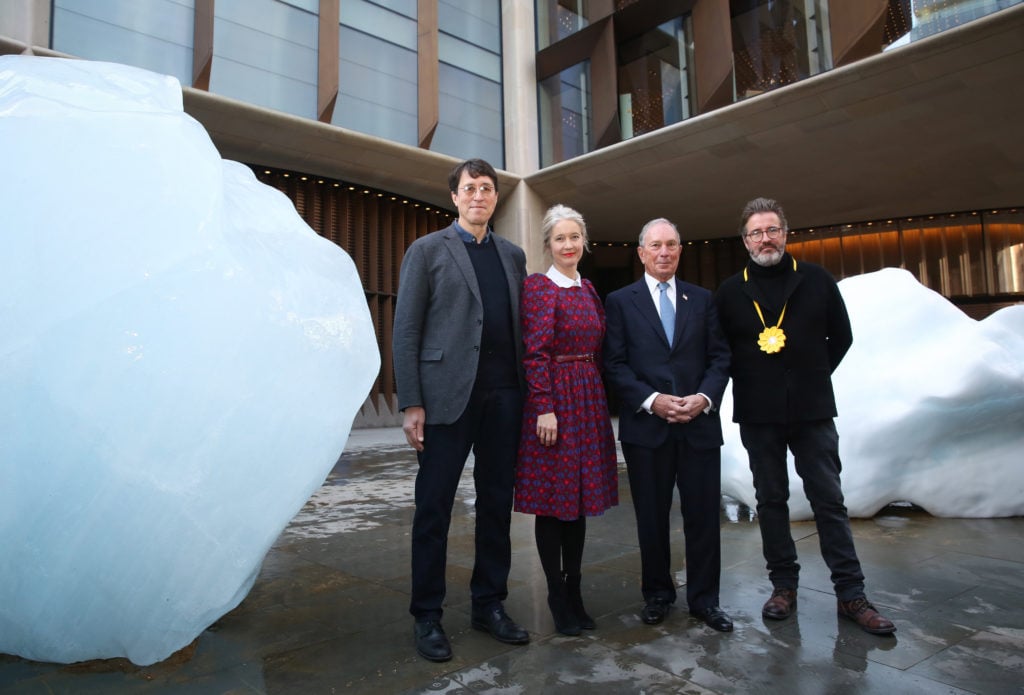On View
Olafur Eliasson Hauls 30 Icebergs to London, Inviting the Public to Contemplate the Devastating Effects of Climate Change
Visitors can climb on, listen to, and even taste the installation as it slowly melts away.

Visitors can climb on, listen to, and even taste the installation as it slowly melts away.

Naomi Rea

Can an encounter with art be more effective in inspiring people to change their behavior than than cold, hard facts? Olafur Eliasson is betting on it.
The Icelandic-Danish artist brought 30 icebergs from a Greenland fjord to London in order to raise awareness about the urgency of climate change. Eliasson salvaged the ice blocks from the ocean after global warming caused them to detach from one of the world’s largest ice sheets. In London, visitors can interact with them—touching them, sliding across them—as they melt in real time.
On Tuesday morning, a ring of 24 of these icebergs was unveiled on the banks of the River Thames in front of Tate Modern, where Eliasson will be the subject of a retrospective in 2019. Six more have been installed outside of Bloomberg’s art-filled headquarters in the city’s financial district. (The project is supported by Bloomberg Philanthropies, and Michael Bloomberg, who is also a special envoy for climate action for the UN. The former New York mayor attended the unveiling with Justine Simons, London’s deputy mayor for culture.)
The installation, called Ice Watch London, is made of materials that are centuries, or perhaps millennia-old lumps of compressed snow, frozen long before the earth’s atmosphere was polluted by humanity. The artist, along with a geologist from Greenland, Minik Rosing, fished the segments weighing between 1.5 and 6 tons out of the Nuup Kangerlua fjord in southwestern Greenland. The blocks used to be part of the Greenland ice sheet, the second largest body of ice in the world after Antarctica, from which a thousand similar blocks of ice detach every second.

Olafur Eliasson’s London Ice Watch Installation. Photo by Matt Alexander/PA Wire.
The goal, Eliasson tells artnet News, is to give “the millions of people who live in and visit London the opportunity to have a very tangible encounter with the consequences of their actions. It lets them see and feel what we are losing. I really hope that Ice Watch can create feelings of proximity and presence, and make us engage.”
This tangible encounter was not easy to pull off. The blocks were shipped to Immingham in the UK via Denmark in nine refrigerated containers and then brought from the port into London by truck.
Was there concern about the impact this very involved endeavor would itself have on the environment? “Everything we do has a carbon footprint, and of course this includes the things we do to address climate change,” the environmentally conscious artist told us. While massive climate awareness efforts like Ice Watch bring these questions to the fore, Eliasson emphasizes that “we need to think about it in all our activities, it needs to be part of how we think as a society.”
His studio is also working to understand and minimize the environmental impact of the installation, he said. In order to estimate the damage, the studio has enlisted the help of Julie’s Bicycle, a nonprofit organization that supports the creative community to act on climate change and act more sustainably.
The group is working on a full report on carbon footprint of the installation, including personal travel, which will be ready within the next week or so. A spokesperson for the studio told artnet News that the group estimates the average amount of energy expended bringing each of the blocks to London is equivalent to one person flying from London to the Arctic and back to witness the ice melting. In order to ensure the project is sustainable, Eliasson says the organizers plan to donate three times the amount of money it would take to offset the carbon cost to the UK’s largest woodland conservation charity, the Woodland Trust.
Eliasson has mounted the installation twice before, in Copenhagen in 2014, and in Paris the following year (for which he also worked with Julie’s Bicycle).

Minik Rosing, Justine Simons, Michael R Bloomberg, and Olafur Eliasson with the installation outside Bloomberg.
Photo by Matt Alexander/PA Wire.
In a statement, the geologist Minik Rosing noted that the melting of ice in Greenland has raised the global sea level by 2.5 millimeters (around one-tenth of an inch). Since the discovery of the greenhouse effect in 1896, global temperatures have increased by more than one degree Celsius (33.8 degrees Fahrenheit).
“Earth is changing at an ever-increasing speed,” Rosing said. “The foundation of human civilization withers away while Greenland melts. Everyone can observe it, most can understand it, and nobody can avoid it. Science and technology have made it possible for us to destabilize Earth’s climate, but now that we understand the mechanisms behind these changes, we have the power to prevent them from growing.”
The installation comes around a month after an intergovernmental panel issued an alarming study warning that humanity has just 12 years to limit the worst effects of climate change. Eliasson’s project also coincides with a meeting of world leaders at the COP24 climate change conference in Poland, which concludes on December 14.
As Londoners climb up the blocks, slide down them, and listen to the soft crackling of the melting snow, Eliasson hopes they will feel—and not just intellectually know—just how thin the ice we’re standing on is.
Ice Watch London will remain in place until December 21, after which, if there is any remaining ice, it will go on show in local cultural institutions working to educate people about the effects of climate change.